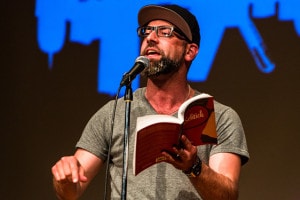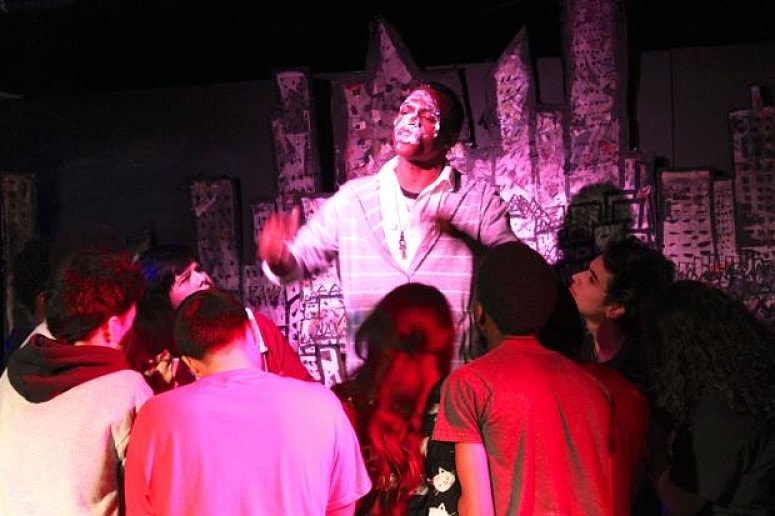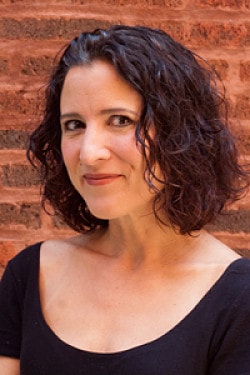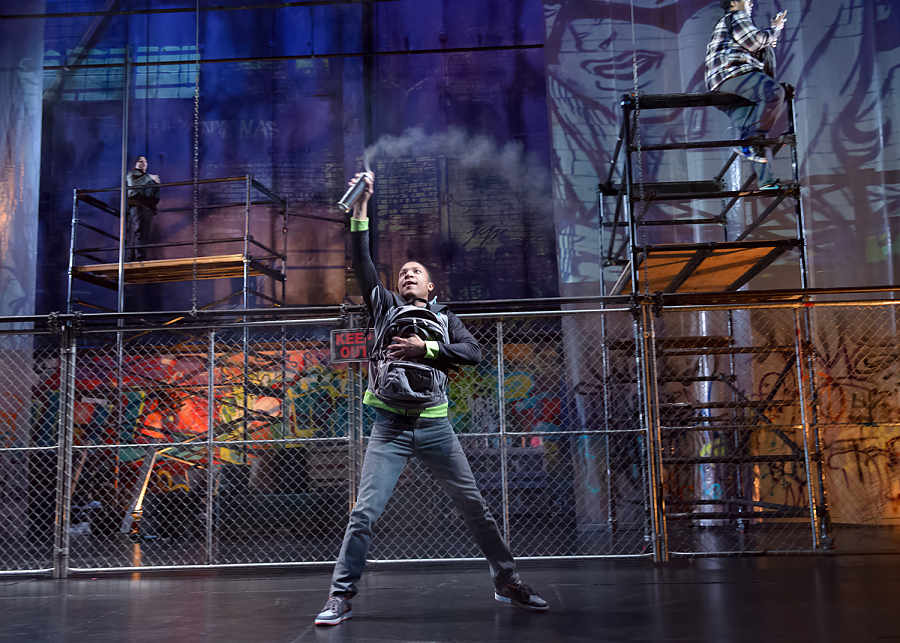CHICAGO: A new play about graffiti, and the competing issues of artistic freedom and private property it raises, has precipitated a veritable firestorm of debate and discussion in the Windy City, with accusations of racism and elitism being hurled by longtime Chicago theatremakers at head critics from the city’s two major papers, against the backdrop of a larger discourse about representation, access, and the purpose of criticism.
This Is Modern Art opened at the end of February as part of the Steppenwolf Theatre for Young Adults series, which programs work aimed at high school students. Based on actual events in 2010, Idris Goodwin and Kevin Coval’s play follows a graffiti crew who tag the modern wing of the city’s Art Institute. This didn’t sit well with critics at the city’s two major daily papers, who criticized the morality of the piece; it was inappropriate, they argued, to show a play championing graffiti to impressionable high school students without presenting the risks and damage it can cause.
What followed was a slew of social media push back from those in Chicago’s theatre scene, who accused both the Tribune’s Chris Jones and Sun-Times’ Hedy Weiss of being out of touch, and worse.
“If you ask me what’s personally difficult, it’s to be called a racist, as I was, and to be called an idiot,” says Jones over the phone in response to those who’ve criticized his review. “I would not say to a person of a particular race or generation or gender or anything that they had no right to write about something outside their experience.
“I don’t reject the notion that I have a limited view,” continues Jones, who has reviewed theatre for the Tribune for more than 15 years. “Obviously, I am who I am. Anybody in my job is one person, one identity. They say, ‘He’s older.’ Well, when I started, I was younger. I started writing reviews in Chicago in my 20s. Guess what—this just in—I’m now older. Does that mean I’m suddenly no good, of no value? Because I have grown older in this job?”
A week after the play opened, Jones and This is Modern Art cowriter Kevin Coval appeared on radio station WBEZ’s Afternoon Shift. Via phone, Jones said to Coval, “Kevin, you called me an old white guy working for a dying newspaper.”
To which Coval replied, “I didn’t mean to offend you—I just thought that that was true.”
What’s “Appropriate”?
Coval, who cofounded the world’s largest youth poetry festival, Louder Than a Bomb, says the two critics completely missed the play’s messages about those disenfranchised by inner-city racism. He says that he and Goodwin intended the play as both a homage to graffiti and hip-hop culture, and a tool for speaking to larger social issues within the city.

“Graffiti operates at the level of metaphor for voices that exist at the margins of culture who have been deliberately excluded or erased from dominate discourse,” he says. Additionally, Coval says, the two critics’ concerns about the morality of graffiti insult the intelligence of the show’s target audiences.
“Just because they see Romeo and Juliet doesn’t mean they’re taking poison at the end of the show,” Coval says. “I think they understand the play at multiple levels. And I don’t think the play terrifies them as it does these critics, because it’s in a language that puts young people in Chicago at the center of the conversation.”
Steppenwolf for Young Adults artistic director Hallie Gordon says she wouldn’t have programmed the show had it been an inappropriate topic for young people. She points to past shows they’ve produced for the young adults series, like To Kill a Mockingbird and Animal Farm—shows which received critical acclaim, but ultimately ended up being more popular with adults.
“A lot of times, kids fall asleep to those,” Gordon confesses. “They understand it as something they have to absorb for medicine, for lack of a better term. That’s not to say those texts aren’t worthy, but when a kid walks into this theatre and they see a world that represents them, they feel like they’re being heard.”
While Steppenwolf’s Young Audience programming is aimed at teens ages 15-18, some of the language and themes in This is Modern Art would be more typically found in an R-rated film. Both Jones and Weiss had concerns about this aspect of the play; Jones, in particular, took issue with a scene in which the show’s main characters address the audience directly and give a kind of “lesson in graffiti”—a breakdown that involves alternative uses for condoms and how to best prepare to serve jail time.
Gordon, though, defends both the show’s language and its more adult themes. The characters, she says, must feel real or the young people in the audience will dismiss them as inauthentic.
“This is an age group I have spent a significant amount of my career working with,” Gordon says. “The way in which they engage with theatre—some of them never coming to the theatre before—is when there are characters onstage that they can recognize.”
A Chicago Voice Censored
But other organizations in Chicago haven’t fared as well with work created by and for young audiences. Two years ago, Yollocalli Arts Reach, located in the city’s heavily Latino Pilsen neighborhood, developed a teen-written show criticizing Chicago Mayor Rahm Emanuel on a slew of topics, including his decision to close nearly 50 public schools in 2013.
The organization—a nonprofit youth arts group—was receiving funding via After School Matters, a city-funded nonprofit. According to Ricardo Gamboa, who worked with the teens and directed the show, Cold Summer, After School Matters threatened to cut funding for Yollocalli unlesss it removed the play’s criticisms of the mayor. (Asked for a response, After School Matters sent an email that said, in part, that the organization “strongly discourages any content, including but not limited to profanity and defamation, which could be considered disturbing or inappropriate for [young] audiences.”)
“At the time I said, ‘It’s not my play to censor,’” says Gamboa. “So I brought it to the young people and said, ‘Here are the ramifications and here’s the ways this could go down.’”

Rather than censor the play, the teens voted to perform a shorter freestyle sketch piece, but ultimately planned to stage the play in its entirety at a later date using independent funding. The play went on to be produced a year later to sold-out performances at Chicago’s Free Street Theatre.
While Gamboa says he disagrees with the two Chicago critics on Steppenwolf’s responsibility to provide morally sound work for young adults, he says he thinks Jones, especially, had a legitimate point around the question of who exactly is creating this art for young people. It matters, Gamboa says, that this is theatre produced by adults who already have certain levels of privilege.
“I think there’s a bigger turn that’s happened in nonprofit organizations and theatres appropriating social tragedies and social issues and using them for their own productivity,” Gamboa says. “All of it presumes to know young people without letting them speak for themselves. Part of why we’re championing [Steppenwolf] for having this show is because for so long they have not had plays really showcasing people of color.”
The Role of Race
Gamboa’s points about privilege and appropriation have not been lost on social media. Following publication of the two Chicago critics’ reviews, This is Modern Art director Lisa Portes denounced the reviews on Chris Jones’s Facebook page.

“Steppenwolf Theatre has the courage and audacity to produce a show in their 500 seat Downstairs Theatre that has at its center a young, urban multi-ethnic cast,” Portes wrote, “telling a complex story of creativity and resistance against a city that regularly renders them invisible and expendable. And the two lead critics of the two major papers run for their legal briefs. As though these kids aren’t criminalized enough.”
That post received support from dozens of commenters, many of them embedded in Chicago’s theatre scene, like Chicago Reader critics Albert Williams and Jack Helbig, Chicago playwright Jenny Magnus and 500 Clown’s Molly Brennan, who wrote, “Racist, elitist, classist bullshit. F*** these reviews.”
Counters Jones: “I don’t think this had anything to do with race, I truly don’t. I certainly don’t think it had anything to do with class. It’s just an opinion on a show for young people.”
Says Hedy Weiss, “I think the argument has been that I wanted [Steppenwolf] to talk down to their high school audience, and I think, in fact, the opposite. I really do respect that audience, but I don’t believe that a play in which the climatic moment is an absolutely triumphal act of defacement of a major public institution is the right message to send.”
Jones points to his previous support of work by artists of color—in 2014, for instance, he named African-American playwright Ike Holter “Chicagoan of the Year in Theater” for his plays Exit Strategy and Hit the Wall. Among other problems, Jones argues, This is Modern Art is missing the nuances found in Holter’s plays, and ultimately comes off as preachy.
For Ricardo Gamboa, who’s currently getting his doctorate in social and cultural analysis at New York University, it’s the young people of color whose voices are being lost in this debate.
“Young people, it’s not that they’re not intelligent or not political—it’s that they’re not speaking their politics or their intelligence in terms that are always legible to adults.”
In not empowering those young voices directly, Gamboa says, Steppenwolf leaves itself open to criticism.
“They might be attempting to speak with them, but they end of speaking for them. It’s still perpetuating certain dynamics that do not allow these marginalized communities to speak for themselves.”


